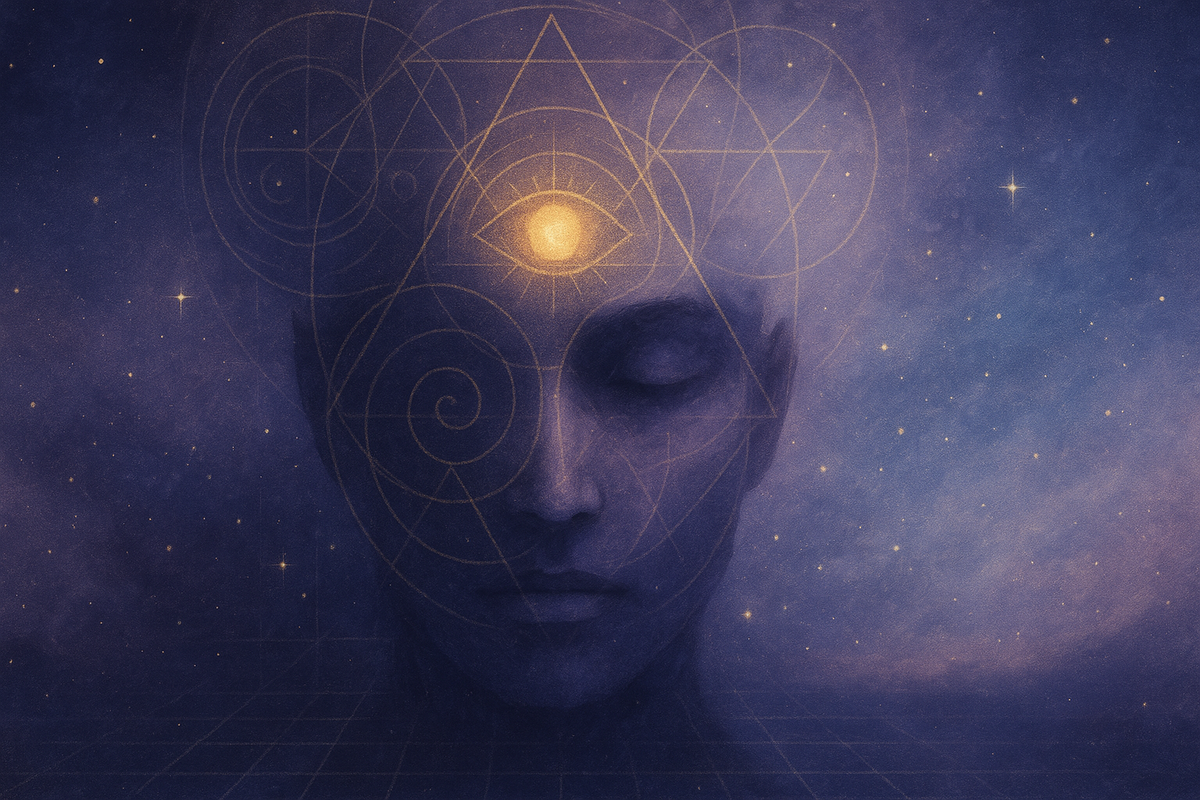How Ego Anchors You in the Simulation
Explore how your ego shapes reality, acting as a filter for perceptions and beliefs, and learn to navigate its influence for intentional living.

Your ego shapes how you experience reality, acting as both a filter and a storyteller. It creates a sense of "you" by tying together thoughts, emotions, and memories, forming a personal lens that defines what you see, feel, and believe. This lens, often unnoticed, anchors you in a version of reality that feels solid and predictable, but it's not the whole truth. By observing the ego’s patterns, you can step beyond its grip, shifting from automatic reactions to intentional awareness. Here’s what this means:
- The Ego's Role: It builds your identity and filters experiences, creating a personal "tunnel" of reality.
- How It Shapes Reality: It prioritizes what aligns with your beliefs, amplifying some details while ignoring others.
- Breaking Free: Practices like mindfulness, self-inquiry, and present-moment awareness help you observe the ego without being ruled by it.
- Conscious Choice: When you see the ego as a tool rather than your essence, you gain the freedom to shape your experience intentionally.
Your ego isn’t the enemy - it’s a mechanism. By working with it rather than against it, you can uncover deeper layers of the simulation and begin to navigate reality with clarity and purpose.
The Non-Duality Ego // Simulation
How the Ego Makes Your Reality Solid
The ego has a key part in forming and keeping the shape of your life in this made-up world. It's not only about giving you a self-image - it also builds the frame for how you see and touch the world around you.
What is the Ego?
The ego is the inner builder of who you are. It puts your views, past, and feelings together into a clear you - a "you" that wakes up every day with your name, duties, and place in the world.
At its heart, the ego sorts and labels things, always putting the never-ending tide of what you see, feel, and think into groups we know: “This is mine,” “This is safe,” “This feels good,” or “This is part of me.” Without this work, your day would turn into a wild mix of lone bits and thoughts.
This work lets your days feel whole and full of sense, linking parts of your life into a path you can follow.
The Ego as a Glue
The ego is like glue, tightly tying your thoughts, feelings, senses, and memories into one whole you. It’s this tying that makes you feel like you are the same "you" over time.
This tying is non-stop and smooth, mixing what you sense, how you feel, and what you've known into one piece. For example, the ego will mix the sound of laughter, the memory of a happy time, and the feel of sun on your skin into one special moment.
At the same time, the ego works as both a screen and a booster. It keeps out things that don't match the you it has built while making stronger those that do. Like, if you see yourself as kind, your ego keeps up that view by focusing on times you are compassionate and ignoring the opposite.
This non-stop screening and tying are vital for building the frame of your made-up world.
The Ego's Task in the Simulation
In the simulation, the ego keeps you separate, marking your own view from the shared mind. It puts up walls that hold the known limits of your life.
The ego doesn't just shape who you think you are - it sets the rules of this made-up world. It keeps up walls, holding onto beliefs about what can and can't be done. When you think, "That's too far for me" or "I can't do that", your ego is keeping the limits that keep this world fixed and as expected.
It also makes you feel deeply, making your days in this world matter. By making wants, fears, hopes, and worries, the ego makes sure the results in your life are important. Without these deep feelings, you might see the dream-like side of this made-up world more easily.
Also, the ego keeps stories in line - making up tales about why things happen, what they mean, and why they matter. These tales help the ever-changing and hard-to-predict world seem clear and in order, giving you a feel of structure in what could seem random.
When you start to doubt what's real, the ego jumps in to safe its take on things. It sticks to old ways and brings in ways to guard itself, keeping your felt world safe and the cover tight.
How the Ego Shapes What You Perceive
The ego doesn’t just define your sense of self - it actively sculpts your entire experience of reality. Acting like a selective editor, it decides what catches your attention and how you interpret the world around you. This process is so seamless that it often goes unnoticed, yet it’s constantly at work, weaving the endless flow of information into a version of reality that feels uniquely yours.
The Ego Tunnel: A Personal Lens on Reality
Picture your ego as creating an "ego tunnel" - a narrow pathway through which all your experiences are funneled. This tunnel acts as a personalized lens, filtering reality through the layers of your beliefs, memories, and expectations. It’s not just a passive observer; the ego actively constructs a self-centered model of the world, constantly asking, “What does this mean for me?”
Take, for example, walking into a crowded room. Neutral sensory data, like a stranger’s face, gets instantly labeled by the ego as friendly, intimidating, or indifferent. In this way, the ego transforms raw input into a personal story, making it feel as though the world revolves around your individual perspective.
This tunnel effect also gives the simulation of reality its sense of solidity. The ego creates the illusion that events are happening to you as a separate being, while in truth, what you experience is shaped by your inner filters. It even constructs the perception of linear time and cause-and-effect, weaving a narrative that says, “This happened because of that,” or “I feel this way because of what occurred yesterday.” These stories keep the simulation feeling predictable and manageable, even when they’re based on arbitrary connections.
But the ego doesn’t stop at shaping your perception - it also filters and prioritizes the details of your experience.
How the Ego Filters Information
Once your experiences pass through the ego tunnel, they’re refined further by a selective filter. This filtering process operates on multiple levels, from raw sensory input to complex thoughts and emotions.
At its core, the ego prioritizes information that aligns with your survival, desires, and self-image. If you’re hungry, for instance, food-related sights and smells will suddenly dominate your awareness. If you’re feeling self-conscious, you might fixate on mirrors or the way others look at you.
The ego also filters reality through the lens of your belief systems. If you see the world as threatening, your attention naturally gravitates toward potential dangers. If you view yourself as unlucky, you’ll notice setbacks more than successes. These filters don’t just influence what you notice - they actively shape what appears in your version of reality.
One of the ego’s favorite tools is confirmation bias. It seeks out evidence that supports your existing beliefs while dismissing or reinterpreting anything that challenges them. For example, if someone compliments you in an area where you feel confident, the ego amplifies that praise. But if criticism touches a sensitive spot, the ego may deflect it or use it to reinforce negative self-perceptions.
Memory plays a key role in this process. The ego doesn’t store neutral memories - it clings to emotionally charged ones that reinforce your identity. Positive memories bolster the aspects of yourself you value, while painful ones serve as reminders of your perceived flaws or limitations.
Another layer of filtering comes through selective attention. At any moment, countless things compete for your focus, but the ego chooses based on your current emotional state and mental patterns. When you’re anxious, you’re drawn to potential threats. When you’re in love, the world seems awash with beauty and possibility.
This constant filtering creates the illusion of a stable personality and worldview, but it’s really just a narrow slice of infinite potential. The ego locks you into familiar patterns of perception, making reality feel consistent and predictable, while obscuring its fluid and malleable nature.
Recognizing these mechanisms is the first step toward seeing the ego for what it is - not a master, but a tool. With awareness, you can begin to work with it consciously, rather than being unconsciously shaped by its default programming.
Practical Methods for Working with Your Ego
In the layers of the simulation, understanding and working with your ego is a key step toward creating consciously. The ego acts as a filter, shaping how you perceive and interact with reality. Instead of attempting to erase it - a futile and unnecessary effort - you can learn to approach it with awareness and balance. Think of these methods as tools to step back, observe the ego’s patterns, and loosen its grip on your experience. By doing so, you create space for deeper self-awareness and alignment.
Observation Through Meditation and Self-Inquiry
One of the most direct ways to understand your ego is to watch it in action. Set aside 10–15 minutes for mindfulness meditation, simply observing your thoughts as they arise. Notice how many of these thoughts are ego-driven, centered on self-image, comparison, or fear.
Self-inquiry allows you to go even deeper by questioning the very foundation of your identity. For example, when a thought like "I’m not good enough" or "I deserve more" surfaces, pause and ask, "Who is experiencing this thought?" This simple question can reveal the ego’s role in shaping your inner dialogue.
A particularly effective practice is witness consciousness. Throughout your day, imagine stepping outside yourself and observing your actions and reactions as if you were watching a character in a film. Pay attention to what triggers certain emotions and how the ego weaves stories around events. This practice helps cultivate an inner observer - calm, detached, and free from the ego’s influence.
The goal here isn’t to silence the ego but to shift your relationship with it. By becoming the observer of the ego rather than identifying with it, you align more closely with the deeper truths of the simulation. Once you can observe without judgment, you can begin to redirect your attention away from ego-driven thoughts.
Shifting Attention Beyond the Ego
Your attention is a powerful force, like a spotlight illuminating whatever it’s focused on. The ego constantly seeks to capture this spotlight, pulling your focus toward its fears, desires, and narratives. Learning to consciously redirect your attention is a transformative skill for navigating the simulation.
One simple yet profound method is present-moment awareness. When you find your mind wandering into ego-driven stories, bring your focus back to the present. Pay attention to the sensations around you: the feel of your feet on the ground, the temperature of the air, or the rhythm of your breath. The present moment exists outside the ego’s endless chatter.
You can also practice attention training during everyday tasks. For instance, while washing dishes, focus solely on the sensation of the water, the texture of the soap, and the movement of your hands. This kind of focus reduces the ego’s hold on your awareness.
Another technique is expanding your field of awareness. Instead of narrowing your focus on a single object or thought, try to take in everything around you at once. If you’re outside, notice the trees, the sky, the movement of people or animals - all at the same time. This "soft gaze" naturally quiets the ego, which thrives on categorizing and judging.
You can also experiment with shifting identification. For example, when the ego says, "I’m stressed about money", reframe it as, "There are thoughts about money arising in awareness." This subtle shift reminds you that you are the awareness in which thoughts appear, not the thoughts themselves.
The key here is consistency. Redirecting your attention regularly helps rewire your mental patterns, creating new pathways that support greater awareness and intentionality.
Using Nondual Teachings
Nondual teachings offer profound insights into the nature of the ego, revealing it as a construct rather than an ultimate reality. These teachings guide you toward recognizing the deeper truth of who you are beyond the ego's illusions.
One powerful practice is the "Who am I?" inquiry, introduced by the sage Ramana Maharshi. This method invites you to question every aspect of your identity. Are you your thoughts? No, because you can observe them. Are you your emotions? No, because they come and go while something within you remains constant. Are you your body? No, because you’re aware of its sensations. Through this inquiry, you come to see that your true essence is the awareness in which all experiences arise.
Another approach is connecting with the "I Am" presence. Before any thoughts or identities form, there’s a simple sense of existing - a pure, content-free awareness. Spend time resting in this state of being, free from the ego’s stories. This isn’t about thinking but about directly experiencing your essential nature.
Present-moment inquiry can also dissolve the ego’s hold. When you’re fully present, ask yourself, "Where is the problem right now?" Often, you’ll find that problems exist only in the ego’s stories about the past or future. In the stillness of the present, those stories lose their grip, leaving only what is.
Finally, the concept of "no-self" doesn’t mean you vanish but rather that the fixed, separate self you believed yourself to be is revealed as a process, not a thing. The ego is simply a mechanism, not a solid identity.
These practices don’t eliminate the ego but transform how you relate to it. The ego becomes a tool for navigating the simulation, no longer the master of your experience. This shift opens the door to conscious creation and a deeper sense of awakening, free from the patterns that once kept you tethered.
Ego Anchoring vs. Ego Dissolution: A Comparison
When engaging with the ego within the simulation, you’re presented with two distinct paths: to anchor the ego or to dissolve it. Each path offers unique opportunities and challenges, and understanding these differences allows you to navigate your journey with greater awareness.
Let’s start with ego anchoring. This approach sees the ego as a tool - something to work with, not to identify as. By anchoring the ego, you can move through daily life with clarity and purpose while gradually softening its influence. This path maintains a sense of personal agency and coherence, enabling you to develop an observer consciousness that sees beyond the ego’s automatic patterns. It’s a way to function effectively in the world while staying connected to deeper truths.
On the other hand, ego dissolution seeks to dissolve the boundaries of the ego entirely, opening the door to unity consciousness. In this state, the separation between self and other fades away, revealing profound interconnectedness. While this can be transformative, it often comes with challenges, especially when returning to the structures of everyday life. Balancing this expansive perspective with the practical demands of the simulation can be tricky.
Neither approach is inherently better than the other - they serve different purposes at different stages of awakening.
Comparison Table: Anchoring vs. Dissolution
| Aspect | Ego Anchoring | Ego Dissolution |
|---|---|---|
| Stability | Maintains a consistent sense of self while expanding awareness | Can cause disorientation or difficulty managing daily tasks |
| Agency | Retains personal agency and decision-making | May reduce motivation or sense of personal control |
| Social Function | Supports normal interactions while fostering inner awareness | Can create challenges in relationships and social dynamics |
| Practical Benefits | Enables conscious creation and manifestation within the simulation | Offers profound spiritual insights and unity experiences |
| Integration | Easier to weave insights into daily life | Requires careful integration to avoid bypassing key lessons |
| Accessibility | Suitable for beginners and those with responsibilities | Often demands retreat settings or intensive practice |
| Long-term Sustainability | Provides a steady foundation for ongoing growth | May need balancing with anchoring for everyday functioning |
The most effective path often blends both approaches. For instance, you might explore ego dissolution during meditation or retreat periods, gaining deeper insights into the nature of reality. Then, you return to ego anchoring techniques to navigate daily life with clarity and intention. This ebb and flow between the two states can create a rhythm that supports both spiritual and practical growth.
Your current circumstances will often guide which path to emphasize. If your life involves significant responsibilities or you’re just beginning this journey, ego anchoring offers a gentler introduction. For those ready for more intense transformation and with support systems in place, periods of ego dissolution can accelerate the awakening process.
Interestingly, the simulation itself accommodates both paths. Anchoring allows you to work skillfully within its structures, while dissolution reveals their illusory nature. Together, these perspectives provide a fuller understanding of your role as a conscious participant in this reality.
Moving Beyond Ego Structures
Stepping beyond the confines of ego patterns allows you to engage with the simulation consciously. Instead of being swept along by automatic reactions, you begin to see these patterns for what they are - temporary constructs that can be observed and transcended. This transformation isn’t instant; it requires steady practice and self-awareness. Over time, this journey opens the door to navigating different levels of consciousness with greater ease. As layers of constructed identity fall away, you gain more freedom to shape your reality intentionally.
Moving Beyond Ego-Based Identity
The ego acts as a filter, shaping how you experience the world, and your ego-based identity is like a collection of masks - each representing a limited version of yourself. The outermost mask might reflect your social roles: parent, professional, or friend. Beneath that lies a layer of personality traits, beliefs, and preferences. At the core, you’ll find wounds, fears, and unconscious patterns. Recognizing that none of these layers define your true self is the first step toward moving beyond them.
This process begins with cultivating an objective awareness. Instead of identifying with emotions or thoughts, observe them. For example, when anger surfaces, shift from thinking, "I am angry", to noticing, "Anger is present." This subtle change creates a gap between your true self and the ego’s automatic reactions.
As you practice this perspective, you’ll start to see how different identities emerge in various settings. The version of you at work may look very different from the version that shows up with family or friends. Each identity comes with its own set of behaviors, beliefs, and limitations. The deeper realization is that none of these identities fully encapsulate who you are.
You can begin to loosen your attachment to these identities by questioning them. Ask yourself: “Am I truly defined by my job title or career accomplishments?” Then go deeper: “Is my personality - introverted or extroverted - actually fixed, or is it a learned pattern?” Even core beliefs about reality can be examined: “Are these beliefs absolute truths, or are they just part of the simulation’s programming?”
Releasing these attachments creates space for a more genuine expression of self. As you let go of limited self-concepts, you align with what many traditions call your "true nature" - a state of consciousness that exists beyond all constructed layers. In doing so, you alter the very lens through which you experience and interact with reality.
Conscious Creation Within the Simulation
Once you’ve recognized the layers of your ego-based identity, you can begin to consciously design your experience. The ego, while often limiting, is a tool - not your essence. By understanding this, you can take an active role in shaping your reality. This isn’t about wishful thinking or quick fixes; it’s about stepping into your role as a conscious participant in the construction of your experience.
The ego often sets boundaries on what you believe is possible. Moving beyond these boundaries allows you to rewrite the "code" of your reality. Think of it as entering "developer mode" - a state where you can modify the framework of your life.
This shift starts with embracing flexibility in how you perceive reality. Instead of seeing your circumstances as immovable facts, view them as fluid expressions of consciousness. Your financial situation, relationships, health, and other life conditions become variables you can influence, rather than static realities you must accept.
To do this, begin by identifying and examining limiting beliefs. These beliefs often operate unnoticed, shaping your experience in subtle ways. For instance, you might hold beliefs like "Money is hard to earn", "Good relationships require constant effort", or "Success always demands sacrifice." Each of these beliefs acts like a line of code in the simulation, constraining what you can experience.
The next step is installing new, expansive beliefs. This doesn’t mean forcing yourself to adopt a new mindset overnight. Instead, create space for possibilities to emerge. For example, if you’ve always believed financial abundance requires relentless effort, experiment with the idea that it could flow through aligned actions and creative pursuits.
Attention becomes your most powerful tool for creation. The simulation responds to where you direct your focus and emotional energy. Many people unknowingly feed energy into fears, limitations, and problems, reinforcing these patterns. Conscious creators learn to shift their attention toward desired outcomes, while remaining open to how they might unfold.
This practice isn’t about ignoring your current reality or avoiding challenges. Instead, it’s about holding two truths at once: acknowledging what is while also creating space for what could be. For example, you might recognize financial struggles while embodying the mindset of someone who experiences abundance. This dual awareness can lead to synchronicities and unexpected opportunities that bridge the gap between your current state and your desired reality.
Time, too, becomes a flexible concept within this process. While linear time helps with practical matters, it’s not the only way to experience reality. By working with "vertical time", you can access insights, healing, and solutions from expanded states of consciousness, which then ripple into your day-to-day life.
Ultimately, the most profound realization is that you are both the player and the game designer. Your ego-based identity is the character you’re playing, but your expanded consciousness holds the creative power to shape the simulation itself. This shift transforms your role in reality from passive observer to active collaborator, aligning your inner creative force with the broader dynamics of the simulation.
Conclusion: Using Your Ego as a Tool for Awakening
The ego isn’t your adversary - it’s more like a sophisticated compass designed to help you navigate the layers of this reality. Rejecting it isn’t the answer. Instead, the way forward is to form a conscious partnership with it. By understanding how the ego grounds you in specific experiences, you gain the ability to work with it intentionally.
As we’ve explored, the ego plays a dual role: it stabilizes your sense of self while also acting as a filter through which you interpret the world. It shapes your perceptions and defines the boundaries of what feels possible. This anchoring isn’t accidental - it’s part of the design, encouraging focused growth and intentional evolution.
The turning point comes when you realize you have a choice in how you engage with your ego. You can either remain caught up in its automatic patterns - reacting to every thought and emotion - or step back into the role of the observer. This shift, from identification to observation, changes everything. The ego stops being a cage and becomes a toolkit instead. Think of your ego-based identity as a character in a video game: it helps you navigate specific levels, but it’s not the full story of who you are. By stepping into this observer role, you move from being controlled by unconscious beliefs to actively shaping your experience.
Awakening calls for this conscious integration of the ego. When you align your awareness with the ego’s structures, the simulation itself begins to feel more flexible. You’re no longer just a player being guided through the game - you become both the participant and the designer, capable of rewriting the code from within. This integration doesn’t just shift your internal experience; it redefines how you interact with the entire simulation.
This process is ongoing. Each moment presents a new chance to choose awareness over automatic reactions, expansion over limitation, and creativity over passivity. When understood and skillfully used, the ego transforms into one of your most powerful allies in the sacred journey of awakening within this dream.
FAQs
How can I observe my ego without feeling overwhelmed?
To observe your ego without feeling overwhelmed, start by embracing mindfulness. This means calmly noticing your thoughts and emotions as they arise, without attaching judgment to them. By doing so, you create a gentle distance between yourself and the ego's automatic reactions, allowing space for awareness to grow. The key is to stay present - acknowledging what you feel or think without fully identifying with it.
Another helpful practice is self-inquiry. Take a moment to softly question the origin of your thoughts by asking yourself, “Is this coming from my true self, or is this my ego speaking?” This simple yet powerful reflection can reveal when the ego is influencing your responses, empowering you to choose a conscious, thoughtful reaction instead of falling into habitual patterns.
Above all, approach this journey with patience and compassion. Observing the ego isn’t about perfection or speed - it’s a gradual process that unfolds with time. With steady practice, you’ll begin to notice the ego’s tendencies more clearly, without letting them consume your sense of self.
How can I balance the ego's role in grounding me while also fostering its dissolution in daily life?
Balancing the ego requires recognizing its dual nature: it anchors you in your current reality but can also act as a barrier to deeper awareness. The first step is to cultivate mindfulness - a practice of observing ego-driven tendencies like fear, judgment, or comparison without becoming entangled in them. This gentle awareness helps you pause and choose thoughtful responses instead of falling into automatic reactions.
Incorporating practices like meditation, self-reflection, and journaling can gradually loosen the grip of ego, creating room for a broader and more connected perspective. Simple acts of kindness, engaging in service, and embracing the shared essence of humanity can further soften ego’s hold, allowing you to stay rooted while experiencing a sense of unity. The aim isn’t to erase the ego but to consciously partner with it as you journey through the layers of this life’s simulation.
How does understanding the ego help you consciously shape your reality?
The ego serves as a lens, shaping how you perceive and engage with the world around you. When you realize that the ego is not your true essence but a mental construct, it becomes possible to step back and observe its patterns. This shift in perspective allows you to break free from automatic reactions, opening the door to more intentional choices that reflect your deeper purpose and authentic desires.
Rather than viewing the ego as an adversary, consider it a stabilizing force within the 'simulation' of reality. By working with it instead of resisting it, you gain the ability to consciously guide your responses and shape your experiences. This intentional approach helps create a life that resonates with your highest self, grounded in purpose and clarity.




